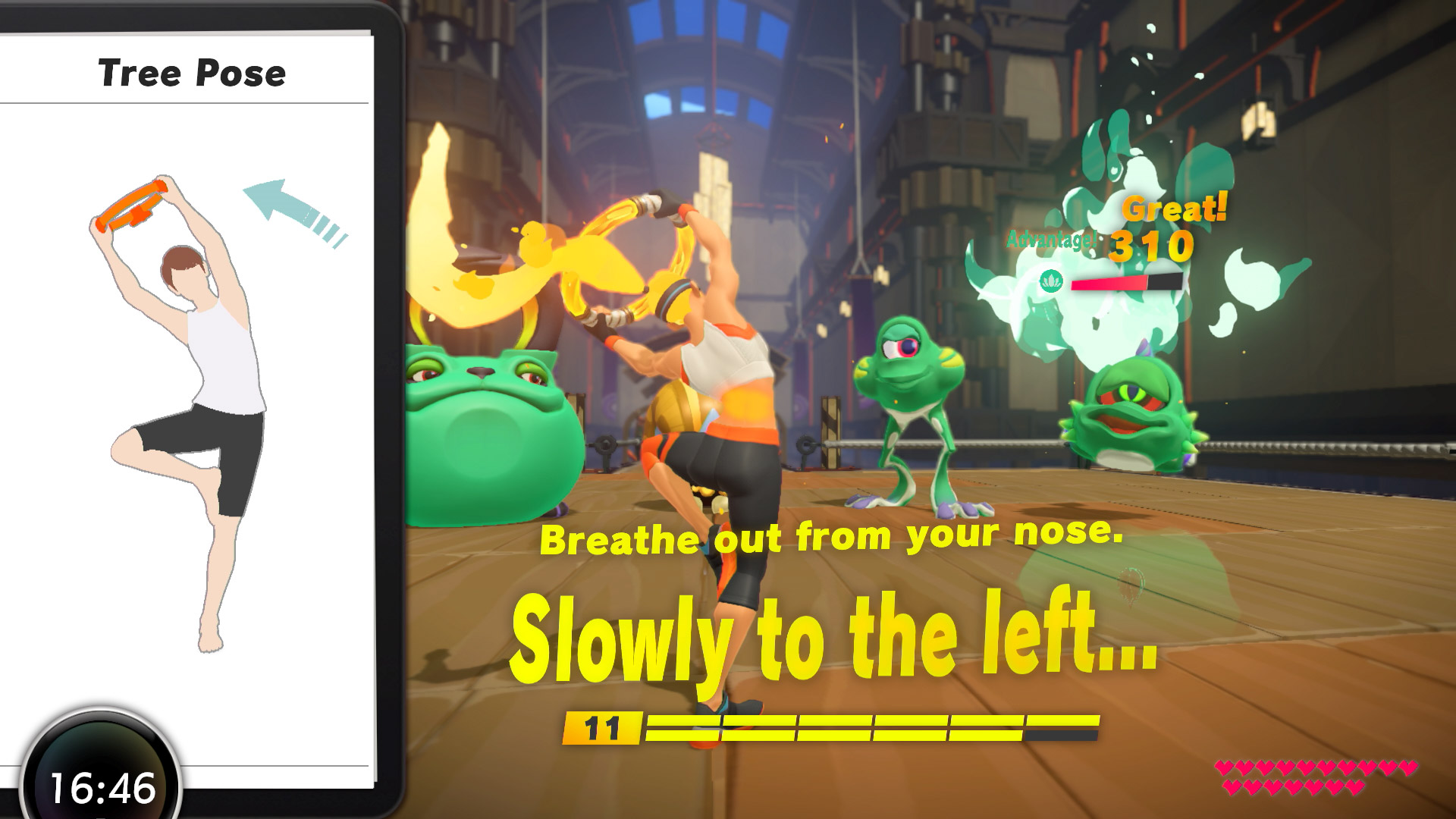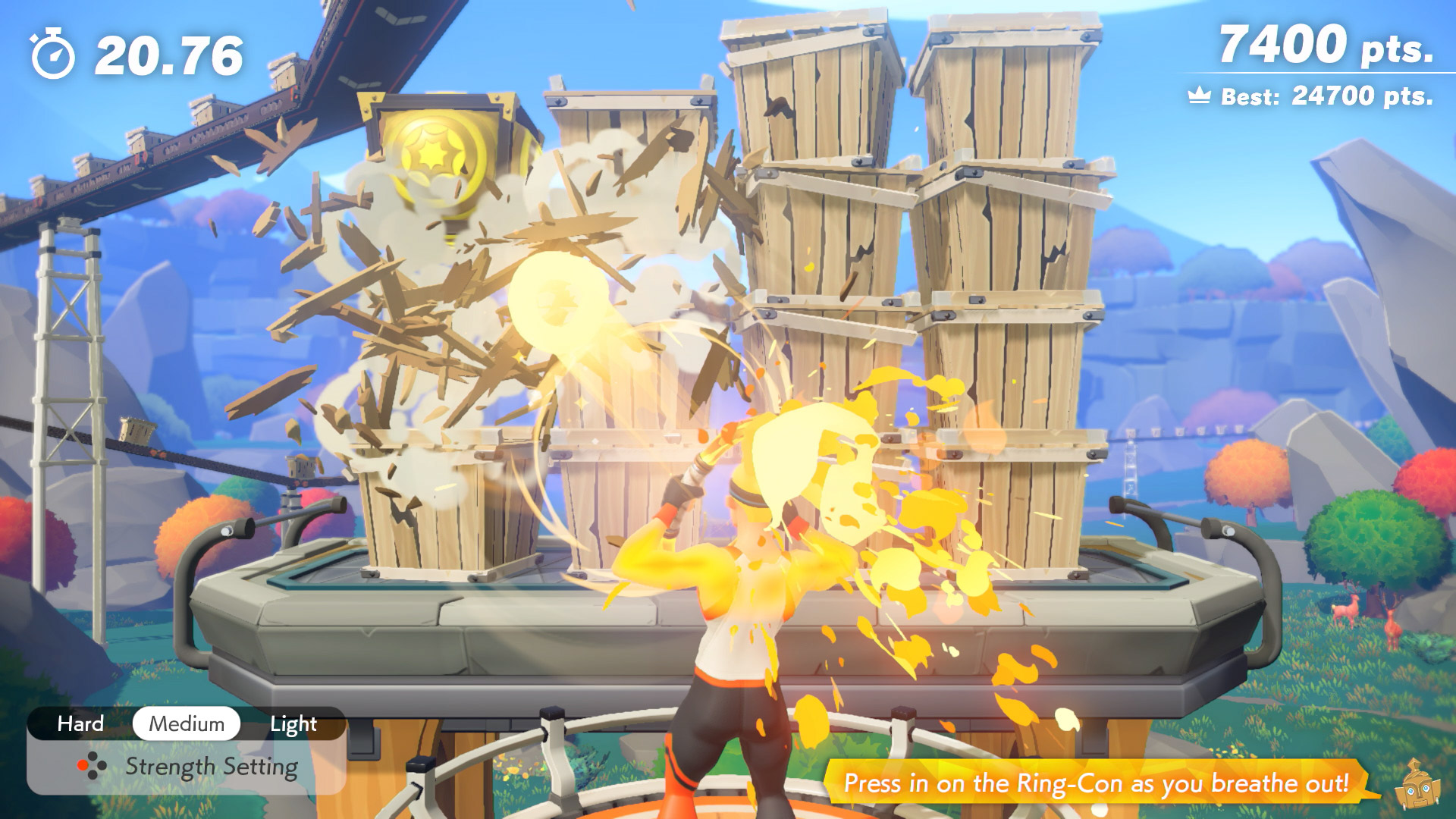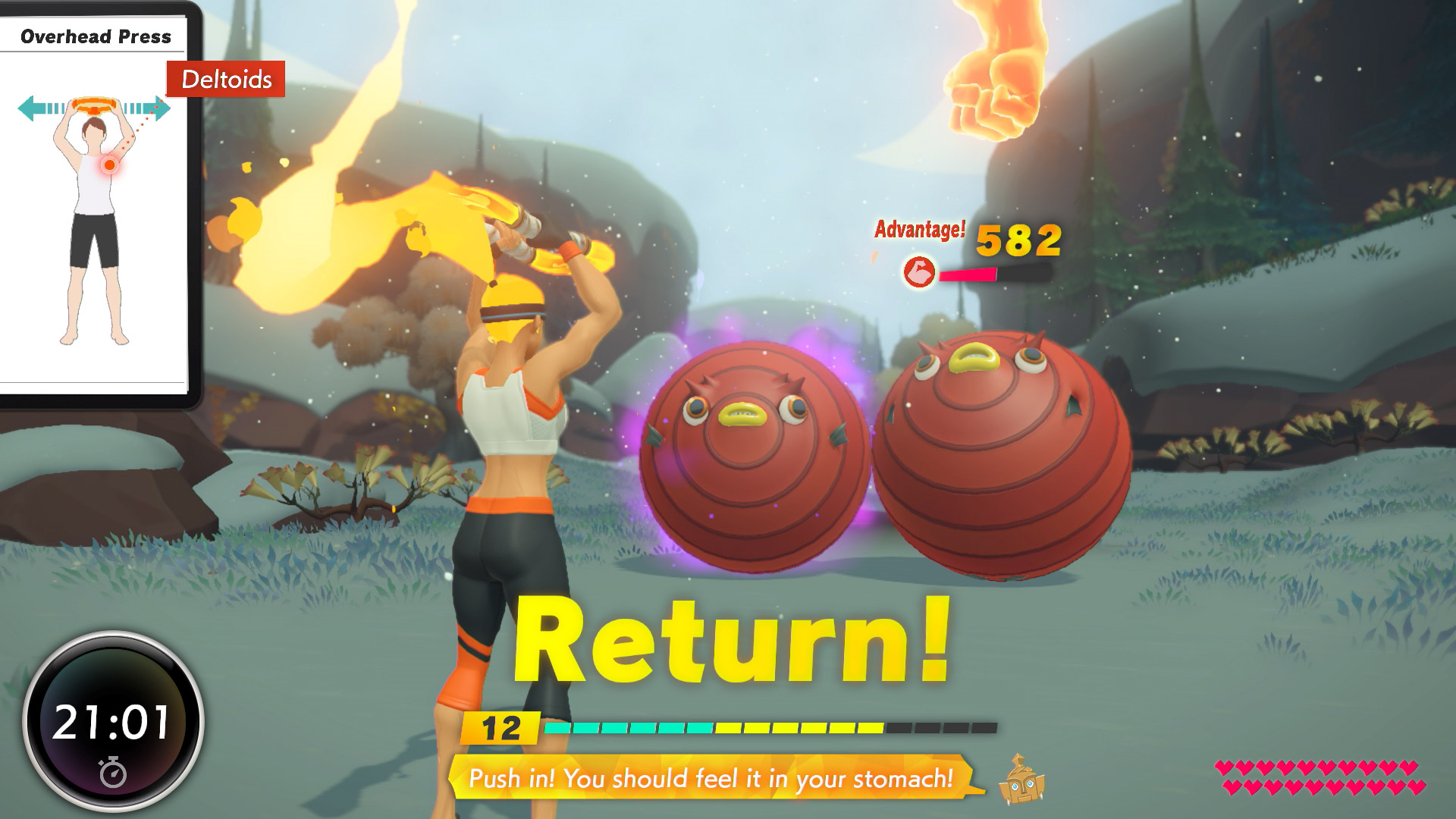I hate exercise.
It’s not that I hate being fit, or exerting myself, or anything like that. I just find typical exercise incredibly boring, and the moment my interest begins to wane even a tiny bit, I’ve already lost. For that reason, I’ve long looked to video games as a potential solution to that problem, as keeping me invested on the gaming side of the package offers me more hope of not giving up on the physical side. In fact, some of the best shape I’ve ever been in in my life was when my local arcade had a selection of Dance Dance Revolution machines, and I was heading there multiple times a week to get my (awkward) groove on.
Nintendo is a company that’s long invested in trying to combine gaming and exercise, and for a while, I had hope that Wii Fit might be something that I’d stick with longer-term. The problem was, it never really felt like a serious, focused piece of software to me. Even though it featured a number of different types of activities, they often seemed disconnected, with an obvious divide between the smaller minigames, the half-hearted exercise routines, and the more serious yoga lessons. I genuinely liked the idea of the Wii Balance Board as an accessory, but it came with obvious limits to its usefulness.

In contrast, I wasn’t sure what to think of the new Ring-Con that comes as part of Nintendo’s latest fitness-focused effort, Ring Fit Adventure. While it’s essentially a Pilates ring with a Joy-Con slot, having never used a Pilates ring myself, I worried that an accessory focus mainly on arm movements would have similar limitations to the leg-focused Wii Balance Board. Still, I was curious, and took up Nintendo’s offer to get a copy of the game for review.
Now, before I go on, let me be clear: This is a review that’s very much still in progress. I came at Ring Fit Adventure not as a reviewer trying to burn though as much of the game as possible in time for embargo—in part because that’d be difficult to do—but as someone who wanted to try to legitimately integrate the game into my daily life in order to get healthier. Basically, the same position most people buying it will be coming from. Because of that, and my commitment to having one proper-lengthed play session a day over the past two weeks, I’m still far off from beating the game, and continue to have a few questions about its long-term potential.
Yes, for those of you who aren’t overly familiar with Ring Fit Adventure, this is an exercise game that you can (theoretically) beat. Unlike Wii Fit and other similar fitness titles, Nintendo built Ring Fit Adventure around the core ideas of an adventure RPG. After entering a few personal details and doing some light customization to your avatar, you’re presented with something quite rare in exercise games: a cinematic cutscene. Here, we meet the Ring-Con’s own avatar named Ring, who’s in need of help in winning back his magical abilities from the hulking gym rat monster Dragaux. At least at the point that I’m at, the story is a pretty simple one of good versus evil—though I’ve come to feel like Dragaux’s “evil” is actually quite often justified—but it serves as the foundation for gameplay that’s very different from what we’ve seen before.

Ring Fit Adventure plays out as a series of worlds, each of which features a progressively larger map dotted with wildlands to explore, towns to buy items or equipment from, or challenges to overcome—all of which leads up to a boss encounter with Dragaux. Explorable areas will be the main focus of your playtime, and having your character run along the (at-times-branching) path requires you to run in place in real life, your movement tracked by strapping the left Joy-Con to your upper left thigh. While traversing the area, manipulating the Ring-Con in different ways produces a variety of results. Squeeze the sides of the band together, and Ring will expel a gust of air that can break open boxes or open doors. Stretch the band horizontally, and Ring will suck in nearby items, allowing you to collect money, ingredients for making health-replenishing smoothies, and more. You can jump by pointing the Ring-Con toward the ground and squeezing it with proper timing, while other more specialized uses pop up from time to time, be it opening chests, destroying path-blocking boulders, or propelling human-powered vehicles.
While Ring Fit Adventure earns its “adventure RPG” title in ways I’ll get to in a moment, I do want to be clear that you won’t be journeying around open worlds or have any freedom to leave the predetermined path. In practice, Ring Fit Adventure can feel more akin to playing an endless runner, where you’re responsible for accelerating your character and making sure their path stays clear, but not much more than that. Still, that doesn’t mean that gameplay here feels shallow. There’s always a variety of things littered about to collect or avoid or get past, and accomplishing all of those with real-world body movements absolutely add a layer of engagement that you might not feel if the only requirement was a constant tap of a finger on a touchscreen.
Things feel decidedly more RPG-y once you’ve engaged enemies in battle. Once an encounter pops up, you’re transported to a separate area to face off against a host of exercise-themed monsters. To defeat them, you’ll need to make use of Fit Skills, attacks that require you to perform a particular exercise based on their category (Arms, Legs, Stomach, or Yoga). For example, in the early going, you might do squats to attack your enemy for 30 points of damage per rep, or hit them for 60 points from each successful tilt of your upper body while in a Warrior I yoga pose. As the game progresses, which Fit Skill you use when gets more important, as certain skills offer the ability to hit multiple targets at once, and enemies start taking more damage if they have a natural weakness to a certain exercise group.

While I could be wrong here, I’m not sure if a game has ever offered a similar type of experience before. And that’s funny, because playing Ring Fit Adventure, its combat system feels both natural and obvious. Why wouldn’t you make a game where you perform a certain exercise to unleash each RPG-styled attack, and why did it take so long for us to get that? At first, I bemoaned the idea of having to sit on the ground for something like the Knee-to-Chest Fit Skill, but it wasn’t long before my focus switched to carefully picking which attack to do when without worrying about its exercise requirements. In those moments, Ring Fit Adventures took me back to my time with Dance Dance Revolution, when I played an exercise game without focusing on or stressing over the exercise. And, though it obviously can’t have use for every exercise, I’ve been impressed by how versatile the Ring-Con can be as a fitness accessory.
That’s not to say that the game’s combat system is perfect, however. One of my two big concerns with Ring Fit Adventure at this point is that, sometimes, its video game side clashes with its exercise side. I’ve run into one specific Fit Skill so far—the Plank—that my body simply refuses to do. Every time I’ve tried it, it hasn’t been pretty, complicated by the fact that it’s hard for me to see the screen from that positon on the ground due to my TV setup. The problem is, avoiding that Fit Skill put me at a disadvantage, since—at the time—it was the most powerful and versatile skill I had for that particular group. What do you do when you simply can’t do a specific exercise but need its better stats to handle that part of the game? I wish that Ring Fit Adventure was more flexible in giving players options for which Fit Skills to use when, as the way it doles each one out leads to there always being a “best” selection to use at any given time—at least, so far as I’ve seen. At my current point of progress, there’s one main option on my in-game menu that I’ve yet to unlock, and I’d love for it to be the ability to level up individual Fit Skills to keep them useful for longer. That way, I could equip my character with the exercises that I want or need to focus on, not just the ones with the highest stats. I don’t expect that I’ll actually get such an option—but I can hope.
While we’re talking about questions I don’t have answers to yet, there’s one huge concern I have for Ring Fit Adventure: What do I do when it’s over? While I have at least a rough idea of how long the game is going to be by knowing the stage number for one of its later worlds, I’m not yet sure when the end will come. When it does, what happens when the game portion of my exercise game comes to a close, but I still want to exercise? That’s the inherent problem to something like Ring Fit Adventure, and the risk to anyone who comes to count on it and its previously-endless motivation. Will we get a New Game+ with remixed worlds and new challenges? Dynamically-generated dungeons? Or… nothing?

Ring Fit Adventure does include a few other options that can promise a more endless experience, but most of them feel like more traditional exercise game fare. In Quick Play, you can pick from a list of challenges put together to focus certain muscle groups, play a variety of decently fun minigames, or go through different sets of exercises combined together to target a specific body part. For those times when you want a more focused yet personalized experience, the Custom option allows you to create a list of Fit Skills and minigames of your choosing to play at any time. Having choices like those are nice—and no doubt necessary—but they don’t have the flair and engagement of the Adventure mode. Finally, as a surprisingly bonus, Multitask Mode lets you use the Ring-Con while the Switch is off to do a bit of extra working out. So, for example, you can do presses and pulls while sitting on the couch watching television, and then get credit for the effort the next time you boot the game up.
The best compliment that I can give Ring Fit Adventure is that it’s a video game that features exercise, instead of an exercise program disguised as a video game. In the two weeks that I’ve been playing my copy, I’ve legitimately regretted any day that I couldn’t play, and have always looked forward to not only exploring deeper into its adventure mode, but actually doing the workout associated with it. Ring Fit Adventure offered me the promise of a game that would keep me motivated and excited to exercise, and so far, it has kept true to that promise—but I’m now worried about what’ll happen once that promise comes to an end.

Mollie got her start in games media via the crazy world of gaming fanzines, and now works at EGM with the goal of covering all of the weird Japanese and niche releases that nobody else on staff cares about. She’s active in the gaming community on a personal level, and an outspoken voice on topics such as equality in gaming, consumer rights, and good UI. Check her out on Bluesky and Mastodon.